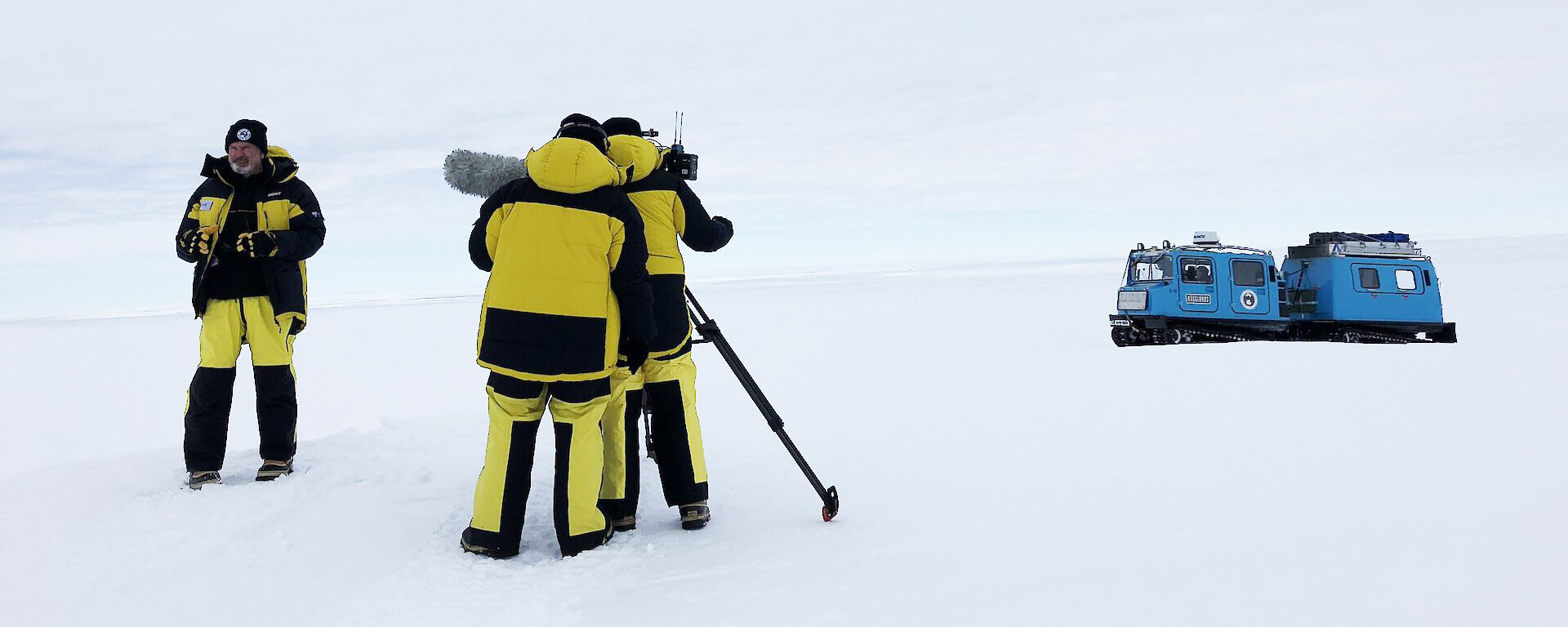Antarctic video gallery
Instant airport
Video transcript
From Mawson station on the coast, the ice sheet rises to a high plateau.
Jagged mountain ranges puncture the glittering ice.
Jan Wallace, Medical Officer Up on the plateau here I just love the expanse of the horizon and the massive sky. It’s a landscape of epic proportions up here, and the mountainscapes around us are just spectacular.
Tom Dacy, Mechanical Supervisor You don’t get many better views than what you get from Rumdoodle Hut and around the lake. There’s some great walking areas around there, and the Rumdoodle Hut this year, we’ve given it a bit of a refurb, so it’s in top condition.
A team of expeditioners from Mawson station is heading 20km inland to Rumdoodle.
Star of the convoy is a well-worn four-tracked monster.
Tom Dacy The Pioneer, she’s a great old girl, a brilliant machine for this sort of task. Got a lot of payload capacity, carry all our fuel, our refuelling sleds that’s needed, and any cargo back to station. It’s a good overland vehicle for the Antarctic conditions.
They mark out an 800 metre runway for flights between Antarctic stations.
Jan Wallace We’re about to receive a plane here from Davis station, so I’m up here in several roles. Hopefully not as the doctor, cos that would be part of an emergency response. Today I’ve been the Hagg driver, and chauffeur for the new passengers coming home.
This area has been used for aviation in the Australian Antarctic Territory since the 1960s
Tom Dacy Normally we’d use the sea ice as a landing area, but the sea ice is no longer usable due to deterioration, so we’ve come up here with all our equipment to receive the plane and its passengers.
Today’s weather report: visibility ‘unlimited.’
Conditions are right for a perfect landing.
‘Rumdoodle International Airport’ is open for summer travel!
[end transcript]
Recruitment 2019
Video transcript
Australian Antarctic Expedition Mechanic, Amy Chetcuti I’m Amy, or Chucs, and I’m an expedition mechanic down here. It’s my first winter.
What does Amy’s year in Antarctica look like?
Want to take your career south?
Applications are open now
jobs.antarctica.gov.au
Amy Chetcuti I would definitely do it again!
APPLY NOW
[end transcript]
Traverse tractors
Video transcript
These heavy-haul tractors have had an extreme makeover.
In Antarctica they’ll endure temperatures down to minus 50 degrees.
AAD Director, Kim Ellis “So we’ve put heaters in the transmission, heaters in the engines, we’ve double glazed the cab, we’ve closed the engine cowlings off to reduce impact of blizzards.”
They’ve also been given a glitzy Australiana paint job.
With vibrant Ken Done designs of the beach, reef, gum trees and outback.
Kim Ellis “Even from a distance it will tell you Australia is here, and then when you get close these snapshots of pieces of Australia represented on the highest and coldest parts of the Antarctic.”
The tractors will lead a traverse train 1200kms inland.
Kim Ellis “It really is a return to this great age of exploration. So we are taking a group of tractors, towing a 500 tonne station, thousands of kilometres across the Antarctic ice, it is the most exciting things you could possibly do.”
The traverse team will initially support scientists drilling for an ice core dating back more than a million years.
All the machinery will be flown to Antarctica over the following months.
[end transcript]
Nuyina video
Video transcript
The RSV Nuyina will be the most sophisticated science ship to ply the Southern Ocean.
Marine Science Support, Rick van den Enden “We are talking a 30 year advancement in research capability, a significant size increase and some of the most advanced science capability for a marine research platform.”
The icebreaker is currently under construction and due in its home port of Hobart in 2020
The search is now on for a hi-tech science team to support the hi-tech ship.
Rick van den Enden “We are after a very broad range of skill sets, everything from laboratory managers, through to precision machinists in an instrument workshop.”
There are 11 roles across 8 different areas;
· Acousticians
· Electronics and mechatronics design engineers
· Laboratory technical officer
· Marine science gear officers
· Mechanical engineers
· Science systems engineers
· Aquarium technician
· Data officers
Rick van den Enden “It’s everything from the routine monitoring, underway sampling instruments that we run on there to any novel science capability that someone has considered. So we have designed the ship to support everything we have envisaged, as well as that stuff we haven’t.”
The new recruits will also provide technical support for deep field science, including the search for an ice core dating back more than a million years.[end transcript]
NASA space robot tested in Antarctica
Video transcript
Could there be life on this icy moon 628 million kilometres from Earth?
NASA/JPL Scientist, Dr Kevin Hand, “We now have good evidence that oceans, oceans of liquid water exist beneath the icy crusts of moons of the outer solar system, these oceans are the prime places to search for life.”
NASA-JPL has built a robot that could one day help find alien life on Europa, one of Jupiter’s 63 moons.
It can float under the ice and move around taking photos and samples.
NASA Engineer, Dr Dan Berisford, “The key reason for having a wheeled rover versus a free-swimming traditional submersible, is that we are really interested in the ice-water interface. When ice freezes, it excludes all sorts of salts and minerals and impurities out of the ice. Right at the ice-water interface you get this enriched layer of chemistry and it’s very conducive to life.”
The robot has been tested in the Arctic and Alaska.
Now it’s headed to Antarctica for the first time.
NASA Engineer, Dr Andy Klesh, “There are many engineering and physics challenges that we have to overcome. How do we charge it, how do we run this thing for so long? These are all the challenges we have to work through, prior to us going out to Europa.”
Once on the moon it will need to drill through 10 kilometres of icy crust to reach the salty ocean.
NASA Engineer, Dr Andy Klesh, “As we descend down through the ice we have to leave these pucks along the way to bounce acoustically these signals all the way up to the surface. And then back to Earth, some many, many millions of kilometres away.”
It’s hoped the robot will be aboard a future NASA mission to Europa.
[end transcript]
Aurora Legacy
Video transcript
GERRY O'DOHERTY — RSV AURORA AUSTRALIS MASTER: We're very fond of the old girl. It will be sad to see it go but it’s the end of an era and this is the last season of this contract for the ship. Look, it may come back to Antarctica in a different role, who knows. But certainly the role that this ship performs now will be superseded by the new ship Nuyina.
PAUL CLARKE — RSV NUYINA CAPTAIN: At this time next year it would be pretty amazing to be doing this same interview but standing somewhere on the Nuyina of course. It’s very exciting for the expeditioners and for everybody involved in the program because it’s a once-in-a-lifetime opportunity to see a huge change.
DONNA WIGHTMAN — DAVIS STATION CHEF: One of the main reasons I signed up for the Davis station voyage in the winter was the new vessel coming along. Coming down on the AA [Aurora Australis] and then going back on the Nuyina is amazing. It definitely was a big decision maker for me and yeah hopefully it still happens!
GERRY O'DOHERTY — RSV AURORA AUSTRALIS MASTER: Oh absolutely, yes of course it would be great to see both ships operating side-by-side in whatever function the Aurora be useful for. It’s still a highly seaworthy and viable ship.
[end transcript]
Delivering the goods
Video transcript
Flt Lt Lucas Webb (Globemaster Captain): Today, we are taking our C-17 Globemaster and the Australian Antarctic Division cargo down to Wilkins Runway, which is just nearby Casey Station, for the first resupply mission of the summer season.
The flight time from Hobart to Wilkins Runway is about four and a half hours, and then once we get there, it’s actually quite different, to see the white continent, and then the runway is the same colour as the surrounding terrain.
We've got an instrument approach procedure that gets us down quite close to the ground, and then we can sort of pick it out. The guys do a very good job of marking it out for us, and making it that bit easier for us to see. The Globemaster lands on various surfaces, including ice, and so from a touchdown and control perspective, after landing, it’s actually fairly similar. But once we slow down, the taxi speed does start to feel a little more slippery than we're used to.
What we're carrying down to Wilkins Runway today is a lot of general cargo, but there are parts for machinery that they have been waiting for, over the winter period.
So the guys are really, you know, hanging out for that stuff.
There’s six missions the C-17 does throughout the summer season. They are highly sought after. Obviously, because of the remote nature, and the highlight it brings to your career. So, it’s definitely something that a lot of people are really keen to get on board.
[end transcript]
Eyes on the Ice
Video transcript
Our entire planet is affected by how Antarctic ice moves and changes.
Over 10 years NASA’s Operation IceBridge has flown the largest survey of Earth’s polar ice.
Now NASA and the Australian Antarctic Program are working together to map sea ice in East Antarctica.
Dr Petra Heil, sea ice physicist: “My work really looks at understanding the sea ice physics, and its real behaviour as it’s a component in the climate system, and the motivation is to understand what the sea ice has done and is doing now in order to forecast what its fate is in the future.”
For the first time from Hobart, NASA will fly over coastal ice in line with their orbiting satellite.
Petra Heil: “A lot of the satellite instruments we use are on satellites that are polar orbiting, and so if you imagine, they all kind of cross or need to travel around the pole, or near the pole; we get a convergence of their trajectories in the sea ice area and over the Antarctic.”
ICESat-2 carries a laser altimeter so accurate it measures ice changes in centimetres from 500 km above.
On the ground, scientists near Casey research station will measure the density of the snow and ice.
Petra Heil: “On the ground, will move along the travel path of the plane, or the satellite, and they take every kilometre probably along a 10km transect very detailed analysis and measurements, take the ice core and send that back.”
The work on the ice is crucial to ‘ground truth’ what’s measured from air and space.
Petra Heil: “It’s exhausting, exhilarating, but it’s incredibly rewarding, and I think you have to be on the ground to really understand the physics in the system that you are working on.”
Production: Mark Horstman, Dan Broun. Vision: Simon Payne, Brett Wilks, Glenn Johnstone, Daleen Koch, Pete Curtis, NASA/GSFC Scientific Visualisation Studio.
[end transcript]


